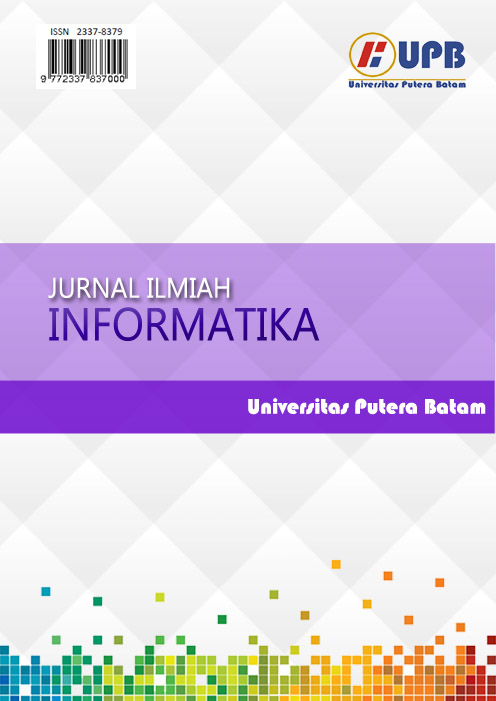RANCANG BANGUN SISTEM LOKER OTOMATIS MENGGUNAKAN QRCODE DAN LAMPU UV DISINFEKTAN
DOI:
https://doi.org/10.33884/jif.v13i01.9923Keywords:
Sistem, Loker, QRCode, Lampu UVAbstract
As technology advances, the level of intelligence in humans increases, so humans always want to create progressive innovations, but besides that, it can also give rise to crime in society. Therefore, security aspects are very much needed in various sectors of life today. One of them is the locker security system which can influence criminal acts. A locker is a place for storage that usually has a lock, which is used to store or place valuable items. One of the facts is that there is often theft and loss of items at places where lockers are rented or borrowed. Thieves can easily open the locker lock using a piece of wire or other artificial keys. This research designs and builds a locker door security system consisting of QRcode sensors, solenoid locks, UV lights, Arduino and other sensor devices. The result of this research is an implementation of a locker security system that can open and close locker locks automatically using Arduino Uno which can provide automatic lock security with a better level of security such as the use of an automatic lock that uses a QRcode scan sensor which only the owner can open by pasting the QRcode code, and additional automatic locks such as a password keypad to open the locker.
References
Hidayat, M. R., Christiono, C., & Sapudin, B. S. (2018). Perancangan Sistem Keamanan Rumah Berbasis Iot Dengan Nodemcu Esp8266 Menggunakan Sensor Pir Hc-Sr501 Dan Sensor Smoke Detector. KILAT, 7(2), 139-148.
Komang, I. (2020). Rancang Bangun Sistem Pengunci Loker Otomatis Dengan Kendali Akses Menggunakan Rfid Dan Sim 800L. Jurnal Ilmiah Mahasiswa Kendali dan Listrik, 1(1), 33-41.
Marpaung, R. G. P., Syarif, E. B., & Atamtajani, A. S. M. (2020). Perancangan Fasilitas Loker Penyimpanan Di Lapangan Gasibu. eProceedings of Art & Design, 7(2).
Maulana, P. R., & Gunawan, S. (2021). Perancangan Lampu Uvc Untuk Disinfektan Ruangan Berbasis Internet of Things (Iot). Jurnal Kajian Teknik Elektro, 6(2), 82-87.
Noor, A. (2018). Lab IT Security System Dengan QR Code Berbasis Web Menggunakan Microcontroller Arduino. Jurnal Sains dan Informatika, 4(1), 34-39.
Subawani, W. (2019). Sistem Pengunci Pintu Otomatis Berbasis Arduino Menggunakan Password. Engineering and Technology International Journal, 1(01), 67-76.
Suwartika, R., & Sembada, G. (2020). Perancangan Sistem Keamanan Menggunakan Solenoid Door Lock Berbasis Arduino Uno pada Pintu Laboratorium di PT. XYZ. Jurnal E-KOMTEK (Elektro-Komputer- Teknik), 4(1), 62-74.
Taqwa, A. T., Adewasti, A. A., & Hesti, E. H. (2019). Rancang Bangun Sistem Keamanan Kunci Loker Mahasiswa di Politeknik Negeri Sriwijaya Menggunakan Fingerprint dan Password Berbasis Arduino Mega 2560 dengan Sim900A. Jurnal TIPS: Jurnal Teknologi Informasi dan Komputer Politeknik Sekayu, 9(2), 39-45.
Utama, Y. P., & Sutopo, J. (2019). KENDALI HAK AKSES PINTU MASUKMENGGUNAKAN QR-CODE (Doctoral dissertation, University of Technology Yogyakarta).
Masykur, Mahdi. Rancang Bangun Sistem Keamanan Loker Mengunakan Sistem Biometrik Sidik Jari. Diss. Universitas Sumatera Utara, 2016.
Candra, Andy, and Farida Nurlaila. "Rancang Bangun Sistem Keamanan Loker Menggunakan RFID Berbasis Arduino Uno Pada Loker Karyawan SMK Yadika 2 Jakarta." Bullet: Jurnal Multidisiplin Ilmu 1.04 (2022): 712-720.
Pradana, Vaizal, and Holy Lydia Wiharto. "Rancang Bangun Smart Locker Menggunakan Rfid Berbasis Arduino Uno." Jurnal EL Sains P-ISSN 2527 (2020): 6336.
Deprimadoni, Deprimadoni. RANCANG BANGUN SISTEM LOKER BERBASIS IOT. Diss. Universitas Andalas, 2022.
Sudarto, Ferry, Juni Aldo Zuntama, and Ikbal Budiono. "Rancang Bangun Sistem Smart Locker Menggunakan Voice Access Berbasis Arduino Mega." Journal Cerita 7.2 (2021): 144-151.
Setyawati, Melia Gripin, and Abdi Darmawan. "Rancang Bangun Kunci Loker Masjid." Prosiding Seminar Nasional Darmajaya. Vol. 1. 2019.
Downloads
Published
How to Cite
Issue
Section
License
Copyright (c) 2025 JURNAL ILMIAH INFORMATIKA

This work is licensed under a Creative Commons Attribution 4.0 International License.






















